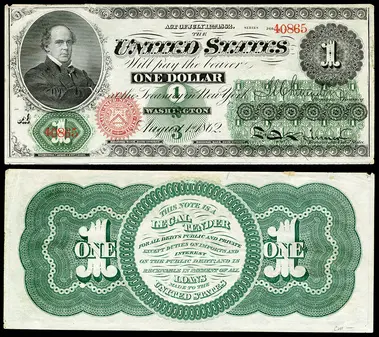Greenbacks - What are They?
Published by Campbell M Gold in Historical · Thursday 25 Jul 2024 · 5:15
Tags: Greenback, US, American, Civil, War, Paper, currency, Slang, term, Emergency, currency, Green, ink, Civil, War, financing, Government, backed, Value, fluctuations, Inflation
Tags: Greenback, US, American, Civil, War, Paper, currency, Slang, term, Emergency, currency, Green, ink, Civil, War, financing, Government, backed, Value, fluctuations, Inflation

Greenbacks - What are They?
"Greenback" is a slang term for the emergency paper currency issued by the U.S. during the American Civil War in the mid-1860s. Its distinctive green ink recognised it.
Initially, the notes were used to finance the Civil War and were backed by the government. However, they were not backed by gold or silver, which led to fluctuations in value and inflation...
Types
There were two types of Greenback Notes:
- Demand Notes (1861–1862): These were the first greenbacks, authorised in July 1861. They bore no interest but could be redeemed for "specie" (coinage, i.e. gold and silver) “on demand.” Initially discounted relative to gold, they soon reached parity. However, redemption was suspended in December 1861.
- United States Notes (1862–1865): These greenbacks were legal tender used to pay duties. Unlike Demand Notes, they couldn’t pay customs duties or interest on public debt. Despite not being backed by gold or silver, they eventually became the official currency of the U.S.

An 1862 One Dollar Greenback
Greenbacks were legal tender. i.e. money that had to be accepted in payment of any debt. Thus, these notes allowed the North to increase the money supply without relying on dwindling gold reserves.
Because the bills were supported only by the government's promise to pay, it was somewhat derisively observed that they were backed only by the green ink on one side. The value of the notes depended on the people's confidence in the U.S. government and its future ability to convert the currency to coin (specie).
Number Issued
The $450 million in authorised greenbacks was later permanently reduced to $346,681,016.
However, fiscal conservatives later demanded their retirement, while farmers and others wanted to maintain high prices.
Although heavily depreciated during the Civil War, greenbacks were much favoured by rural proponents of inflationary monetary policies, who lobbied for their continuance in the late 1860s and 1870s.
Organised as the "Greenback Party", the proponents succeeded in postponing the resumption of specie (coinage, i.e. gold and silver) payments until the Resumption Act of 1875, which, by 1879, had set the greenback to a value on par with metallic currency.
The Greenback movement, active from around 1868 to 1888, aimed to maintain or increase paper money circulation. Agrarian interests largely supported it. The movement’s advocates believed that putting more greenbacks into circulation would make it easier to pay debts and boost prices, leading to prosperity.
Over time, greenbacks moved from wartime necessity to a significant part of the U.S. monetary system.
Manipulation
The manipulation of greenbacks during their issuance involved several key factors:
- Legal Tender Act: The U.S. government passed the Legal Tender Act in 1862, which declared greenbacks as "legal tender for all debts, public and private". This forced full acceptance of the paper currency.
- Quantity Issued: The government printed large quantities of greenbacks to finance the war effort. However, this led to inflation, as the increased money supply diluted their value. This is a problem with money printing (i.e. Quantitative Easing).
- Speculation and Hoarding: Some individuals speculated on greenbacks, buying and selling them based on market fluctuations. Others hoarded them, cashing in on future gains.
- Interest Rates: The government manipulated interest rates to control the value of greenbacks. Higher rates attracted investors, while lower rates encouraged spending.
- Redemption and Retirement: The government periodically redeemed greenbacks for gold or silver, reducing circulation and affecting their value and stability.
Thus, manipulating greenbacks involved legal measures, quantity control, and monetary policy adjustments during a critical period in U.S. history when they could easily get away with it.
Manipulation Consequences
The manipulation of greenbacks had several consequences during the American Civil War and its aftermath:
- Inflation: The increased issuance of greenbacks led to inflation. As the money supply expanded, the value of each greenback decreased, causing rising prices for goods and services.
- Economic Disruptions: The fluctuating value of greenbacks disrupted trade and economic stability. Businesses and individuals faced uncertainty in pricing and transactions.
- Debt Repayment Challenges: Some borrowers benefited from the depreciated value of greenbacks, as they could repay debts with less valuable currency. However, lenders suffered losses.
- Political Debates: The use of greenbacks sparked debates about monetary policy, legal tender, and the role of government in currency issuance, which continued long after the war.
- Legacy: The Greenback movement left a lasting impact on U.S. monetary history. It influenced subsequent currency reforms and discussions about fiat money.
During this pivotal period in U.S. history, the manipulation of the greenback had multifaceted impacts on the economy, politics, and public sentiment, influencing various aspects of government and society in complex ways.
Global Impact
The use of greenbacks in the United States during the American Civil War significantly impacted the global economy.
Other countries' reactions include:
- Suspicion and Scepticism: Other nations initially viewed greenbacks with suspicion since they were not backed by gold or silver, which raised concerns about their value and stability.
- Trade and Exchange Rates: The fluctuating value of greenbacks affected international trade. Some countries adjusted their exchange rates to account for the uncertainty caused by the paper currency.
- Commodity Prices: The increased money supply from greenbacks led to inflation, affecting commodity prices worldwide. Countries that traded with the U.S. saw changes in the prices of goods.
- Financial Markets: Greenbacks influenced global financial markets. Investors and traders closely monitored their circulation and impact on interest rates.
- Legal Challenges: Some countries questioned the legality of greenbacks as legal tender, leading to international legal disputes over their acceptance in cross-border transactions. In summary, using greenbacks had ripple effects beyond U.S. borders, shaping economic policies and trade relations worldwide during a critical period.
Today, "greenback" colloquially refers to U.S. paper dollars in current circulation.
Source: Archives
There are no reviews yet.


